It’s nuts (see what I did there?) how many studies are now discovering the numerous health benefits of nuts. It turns out that they’re actually one of the most health-giving foods on the planet. And while the research may be new — nuts aren’t.
In fact, a 2016 archeological dig in Israel found evidence that nuts formed a major part of our ancestors’ diet 780,000 years ago.
Dig researchers discovered seven varieties of nuts, along with stone tools to crack them open. These stone tools, called “nutting stones,” are similar to those found in the United States and Europe, and archeologists date them back 4,000 to 8,000 years.
Today, many of us enjoy walnuts, almonds, pecans, Brazil nuts, pistachios, cashews, macadamia nuts, and hazelnuts, plus honorary peanuts (even though peanuts are technically a legume) with enthusiasm.
Nuts are a popular plant-based protein source and are often used in dairy analogues like nut milk and nut cheese. And a variety of nut butters have emerged, beyond traditional peanut butter. Yet, we’re only beginning to appreciate the enormous nutritional benefits that nuts give us.
So how healthy are nuts? What actually constitutes a nut? Are there any downsides to eating nuts? And what are the best ways to store and eat them?
Types of Nuts
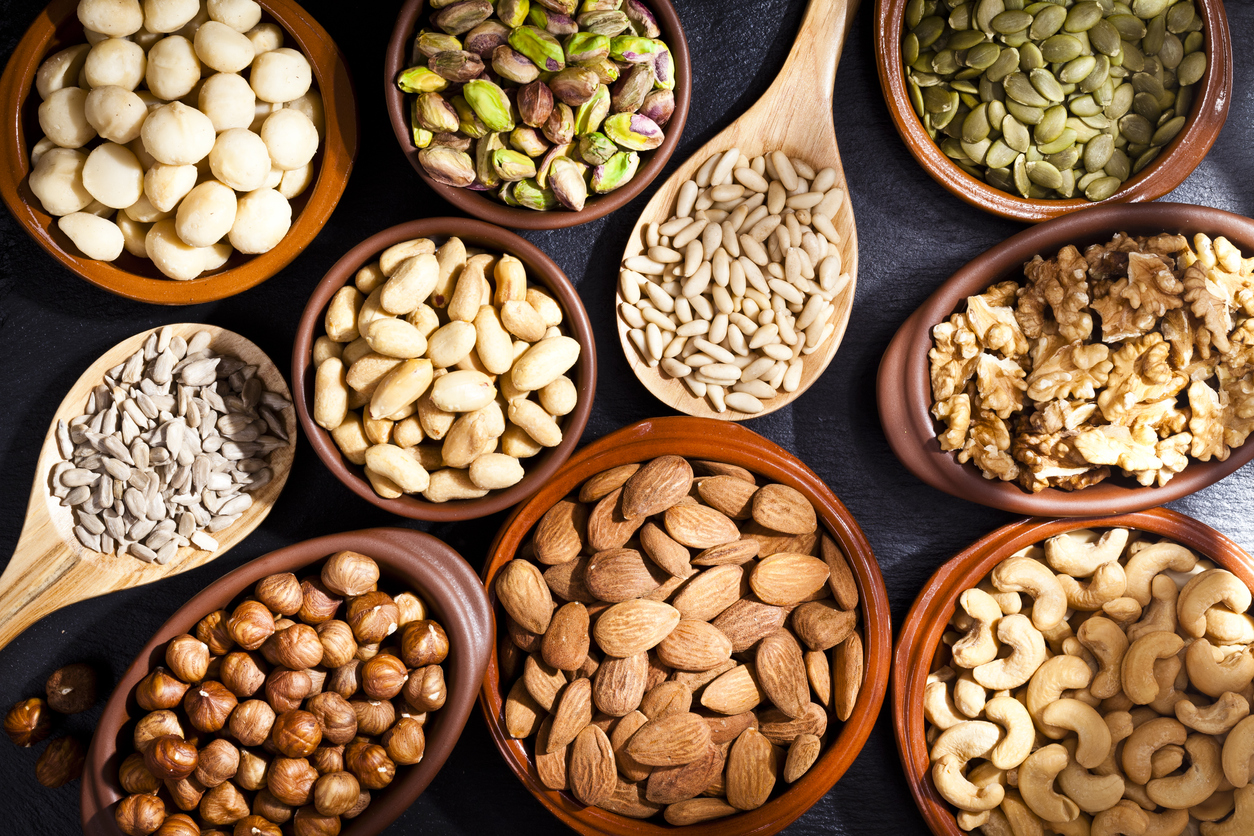
Nuts come in many different shapes and sizes. But most of the different types of nuts fall under the tree nut category. As the name suggests, they grow on trees. But botanically, some of what we know as nuts may technically be fruits, drupes, or seeds.
In general, the word nut is used to describe a hard covering or shell surrounding a kernel or “meat” inside.
Some of the most common types of nuts include:
There are also a few other foods that have “nut” in their name that you may be wondering about. For example, are coconuts nuts? Coconuts are technically drupes because they have three layers: a smooth outer layer, a tough fibrous layer, and the fleshy part surrounding the middle.
Peanuts are also lumped into the nut category but are actually legumes. They’re the edible seeds of the peanut plant and grow underground rather than on a tree. But in terms of culinary usage, they’re very much nutlike.
Additionally, nutmeg does not come from a nut, but from a seed. Water chestnuts are actually roots or tubers. And corn nuts are still corn; they’re just roasted until they’re hard and crunchy like nuts.
Nut Nutrition
Nuts of all sorts have been an important food source for humans for centuries. In fact, it’s theorized that the discovery and inclusion of nuts in our diets may have helped shape our brains and intelligence.
This makes sense when you consider the walnut, especially. Walnuts resemble tiny brains inside a skull. As a result, they were often associated with brain health. But many different nuts have a variety of nutrients beneficial for brain health and beyond.
Nuts are a rich source of complex carbohydrates. Carbs in nuts vary, but cashews and almonds have some of the highest carbohydrate contents at 8.6 and 6.1 grams per one-ounce serving, respectively.
Nuts also contain a good amount of protein, which is why they’re often recommended as a protein source to include in a plant-based diet. Peanuts rank the highest in protein, followed closely by almonds, pistachios, and cashews.
Additionally, nuts contain fiber, contributing to satiety. Hazelnuts and almonds contain the most fiber per ounce at 3 and 4 grams, respectively.
Nuts contain both saturated and unsaturated fats. The high fat content in nuts also contributes to a relatively high amount of calories per serving. If you’re trying to manage weight, you may want to stick to some of the lowest-calorie nuts, such as raw chestnuts or cashews, or limit your portion to no more than one or two ounces per day.
Across the board, nuts also contain significant amounts of vitamins, minerals, and antioxidants. A one-ounce serving of cashews contains 1.9 milligrams of iron, a vital mineral for transporting oxygen in the blood. And almonds, cashews, and peanuts are all good sources of magnesium. A single Brazil nut can also provide an entire daily value’s worth of selenium.
So with all of that to consider, what is the healthiest nut? Opinions may vary, but walnuts have some of the highest antioxidant levels and are also one of the best plant-based sources of omega-3 fatty acids. And researchers found that walnuts had the greatest health benefits among all the nuts studied in PREDIMED, a landmark randomized clinical trial on the Mediterranean diet.
Health Benefits of Nuts Worth Knowing About
When it comes to the health benefits of nuts, there are many worth knowing about. It seems that, unless you’re allergic to them, all nuts might be good for you in one way or another.
Nuts and Heart Health
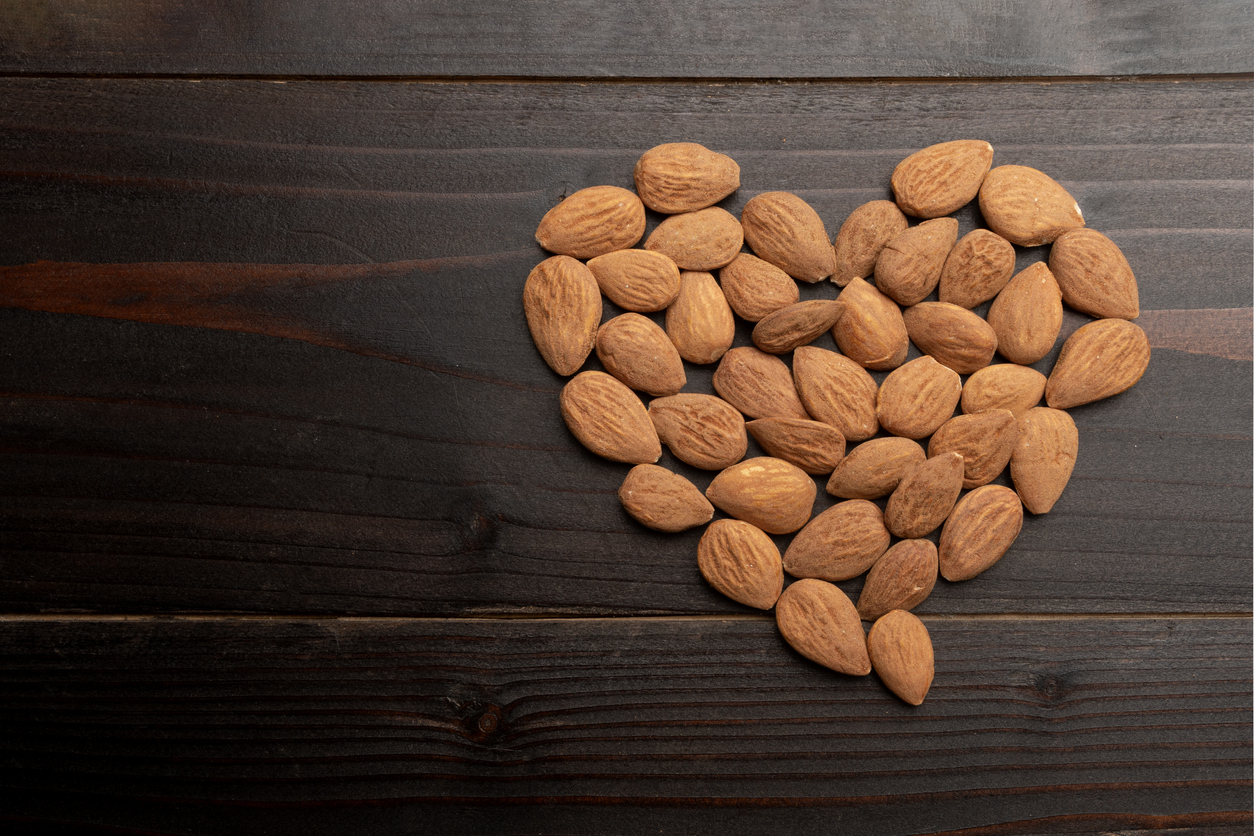
Epidemiologic studies have linked eating nuts with reduced rates of heart disease. And that’s extremely good news for everyone since heart disease is the leading cause of death worldwide.
A review on nuts and cardiovascular disease risk found that higher consumption of nuts worked out to a 19% reduction in disease incidence and a 25% reduction in death from heart disease. Researchers also found a correlation between nuts and lower risk of atrial fibrillation and stroke deaths.
What’s more, a Korean cohort study discovered that even just one 15-gram serving of nuts per week (about half an ounce) was associated with a lowered risk of high blood pressure.
Nuts and Diabetes
Relatedly, recent studies have also indicated that nut consumption may help manage or prevent type 2 diabetes.
Many people with type 2 diabetes also have some form of heart disease due to its metabolic impacts on the body. As a result, researchers used a systematic review to look at the blood lipid levels in people with type 2 diabetes. They found that both peanuts and tree nuts had an impact on total cholesterol and triglycerides in the diets of diabetes patients.
A 2021 meta-analysis of clinical trials also found that tree nut consumption reduced glucose levels and HbA1c levels in patients with type 2 diabetes.
Nuts and Brain Health

Walnuts do indeed look like little brains and may also help with brain health. A 2022 study in the journal Nutrients showed walnuts have a powerful protective effect against neuroinflammation. This is an important quality to have since neuroinflammation is directly linked to the development of neurodegenerative diseases like Alzheimer’s.
Another more recent review also suggests that nuts have a positive impact on cognitive health across the lifespan and may especially help prevent cognitive decline in older adults. In particular, walnuts were noted as the most promising nut in supporting cognition due to their omega-3 fatty acid content.
Nuts and Longevity
Speaking of being protective across your lifespan, a study of Seventh-Day Adventists (a religious denomination that emphasizes healthy living and a vegetarian diet) found that those who ate nuts at least five times per week gained, on average, an extra two years of life expectancy. The nut eaters also experienced a significant reduction in heart disease risk.
And perhaps most dramatically of all, a large-scale, 30-year-long study found that people who regularly ate one ounce of nuts at least seven times per week were 20% less likely to die for any reason, compared to those who avoided nuts in their diet.
Nuts and Cancer

Many nuts have also been linked to lower rates of certain cancers. Studies done on walnuts, in particular, have found that they appear to be particularly protective against breast and prostate cancers. Walnuts and many other nuts contain a number of potent nutrients that may help fight cancer and boost overall health. These nutrients include ellagic acid, a phytochemical, and gamma-tocopherol, an antioxidant and the major form of vitamin E — both of which have strong anti-inflammatory and cancer-protective effects.
Nuts and Erectile Dysfunction
A clinical study published in the International Journal of Impotence Research looked at what happened to men with erectile dysfunction (ED) who ate three to four handfuls of pistachios a day for three weeks. They experienced a significant improvement in blood flow through their private parts. The researchers concluded that three weeks of pistachios “resulted in a significant improvement in erectile function… without any side effects.” That’s pretty impressive, considering the side effects of prescription ED medications.
Results from the FERTINUTS trial, a study examining the impact of nuts on sperm quality, also had positive things to say. The consumption of 60 grams a day of mixed nuts versus no nuts at all showed a significant increase in sexual function and desire among men.
Disadvantages of Nuts
Despite all the impressive health benefits of nuts, there are a few things to consider when adding them to your diet.
Nut Allergies

Perhaps the most obvious downside to nuts is that many children and adults are allergic to them. Tree nut allergies are the most common type of food allergy. And most children with a tree nut allergy are allergic to more than one nut and do not usually outgrow their allergy — as is sometimes the case with other food allergens.
Although peanuts are botanically legumes and not tree nuts, there is also a significant crossover between peanut and tree nut allergies. Around 25–40% of people with a peanut allergy also have a tree nut allergy.
Both peanut and tree nut allergies can have a range of symptoms, from coughing and wheezing to indigestion to hives, and, most severe of all, anaphylaxis. Obviously, if you have a peanut or tree nut allergy, do not consume them.
The American Academy of Allergy, Asthma & Immunology (AAAAI) suggests that seeds (sesame, sunflower, or pumpkin) are often better tolerated in individuals with tree nut allergies. Coconuts, macadamia nuts, and pine nuts are also considered okay for many people with tree nut allergies since the former is botanically a fruit, and the latter two also fall under the seed category. Individuals should consult with their health care team to confirm these foods’ safety.
Nutrient Density
Nuts are some of the most nutrient-dense foods you can eat. This makes sense, considering they are a small package that has the potential to grow into a tree! But because they’re loaded with nutrition (and calories), a little can actually go a long way.
So what’s the recommended serving size of nuts? In general, current dietary guidelines recommend a 30-gram serving, or a little over an ounce. However, a handful has also been suggested as a valid (although, admittedly, not very scientific) nut serving size.
The one exception to this is Brazil nuts. Because a single Brazil nut can contain up to 96 micrograms of selenium, which is almost double the recommended amount, it’s probably best to only consume one to two Brazil nuts per day. Brazil nuts also contain barium, which can be toxic in large doses.
Antinutrients in Nuts
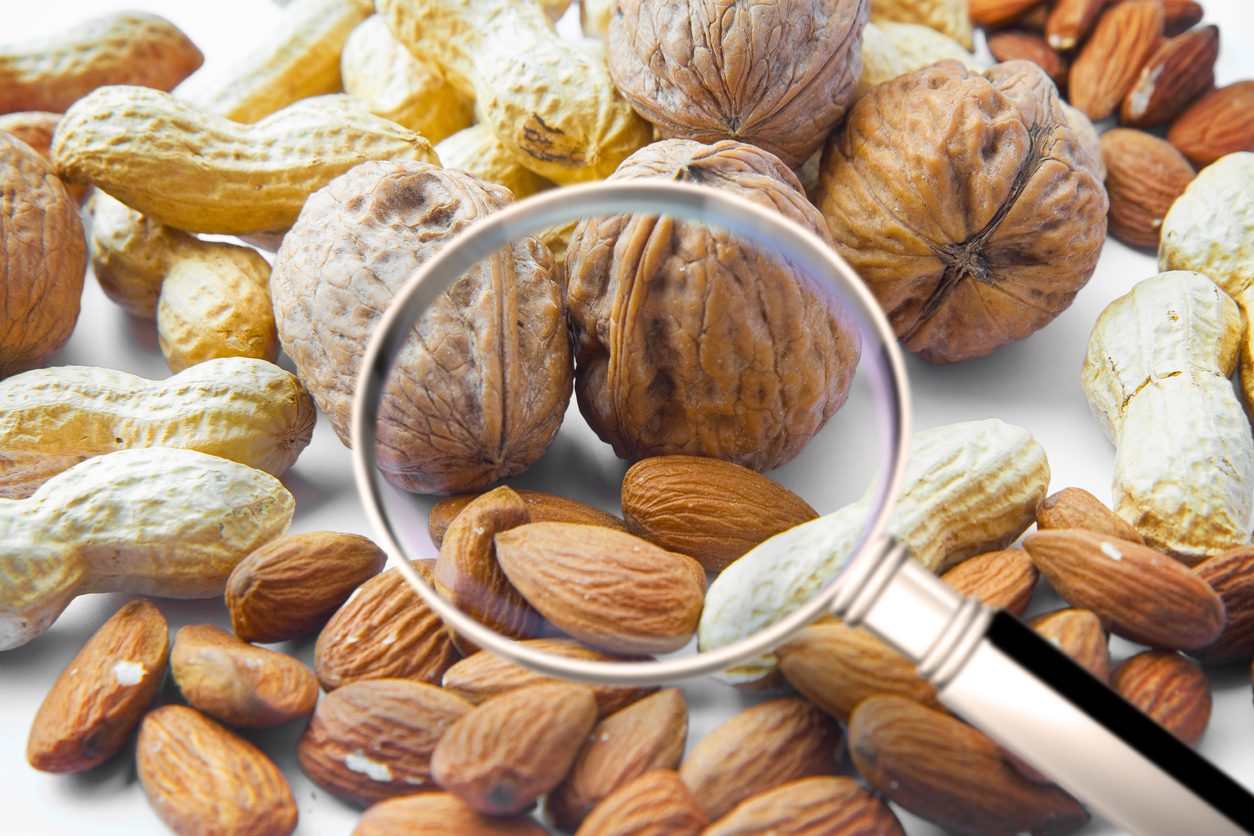
Because nuts and seeds contain the building blocks for new life, they also tend to come with protections in place to ensure that life succeeds. Antinutrients are plant chemicals that are meant to make a plant less tasty, to deter predators.
Nuts contain antinutrients like phytates, tannins, lectins, and oxalates. Antinutrients are so named because they interfere with the absorption of certain nutrients. So, is this a reason to avoid eating nuts?
Although antinutrients are controversial in the nutrition world, they aren’t the bad guy they’re often made out to be. As we’ve seen in this article, nuts have amazing benefits. On the other hand, many studies done on antinutrients examine them in isolation, which is not how they’re consumed.
Antinutrients are found in many plant foods, along with a variety of beneficial vitamins, minerals, antioxidants, and other plant compounds. In fact, their very inclusion may actually contribute to some of the health benefits seen in nuts and other plant-based foods.
So there’s no need to fear antinutrients in nuts. But if you do want to lessen your antinutrient consumption for whatever reason, you can do so by soaking nuts in water for 24–48 hours. Cooking, sprouting, or fermenting nuts also has the same effect.
For more on antinutrients, see our article, here.
How to Enjoy Nuts
Based on numerous studies, it appears that eating at least one serving of nuts a week, and potentially up to a serving per day, may lead to tremendous health benefits. But how you get those benefits is up to you.
You can enjoy nuts straight as a snack, with a sprinkling of salt or other seasoning, in trail mix or granola, or added to smoothies. Nuts also go well in a nut loaf or casserole, as a topping for salads, blended into nut milk, or prepared into nut cheeses, nut butters, or even pie crusts.
However, because nuts contain different types of fat, they’re prone to spoilage. Walnuts, in particular, are high in omega-3s and may go bad more quickly than other nuts. Fresh in-shell walnuts are best. If you’re a little adventurous, you can get a nutcracker and crack them yourself.
If you opt for shelled walnuts, store them in airtight containers in the refrigerator to prevent their oils from going rancid. According to the University of California Agricultural and Natural Resources, nuts will retain their nutritional and flavor quality for up to one year if stored in the refrigerator or two years in the freezer.
You can find out how long each type of nut lasts in this infographic:

And, of course, a food is only as healthy as the company it keeps. When nuts are overly salted or laden with sugar or with artificial additives and flavorings, they lose much of their nutritional value and can become a less healthy choice.
Nut Recipes
Enjoy nuts of all varieties for breakfast, lunch, dinner, and dessert with these outrageously nutty and wonderfully delicious nut recipes!
1. Toasted Pistachio and Cherry Overnight Oats
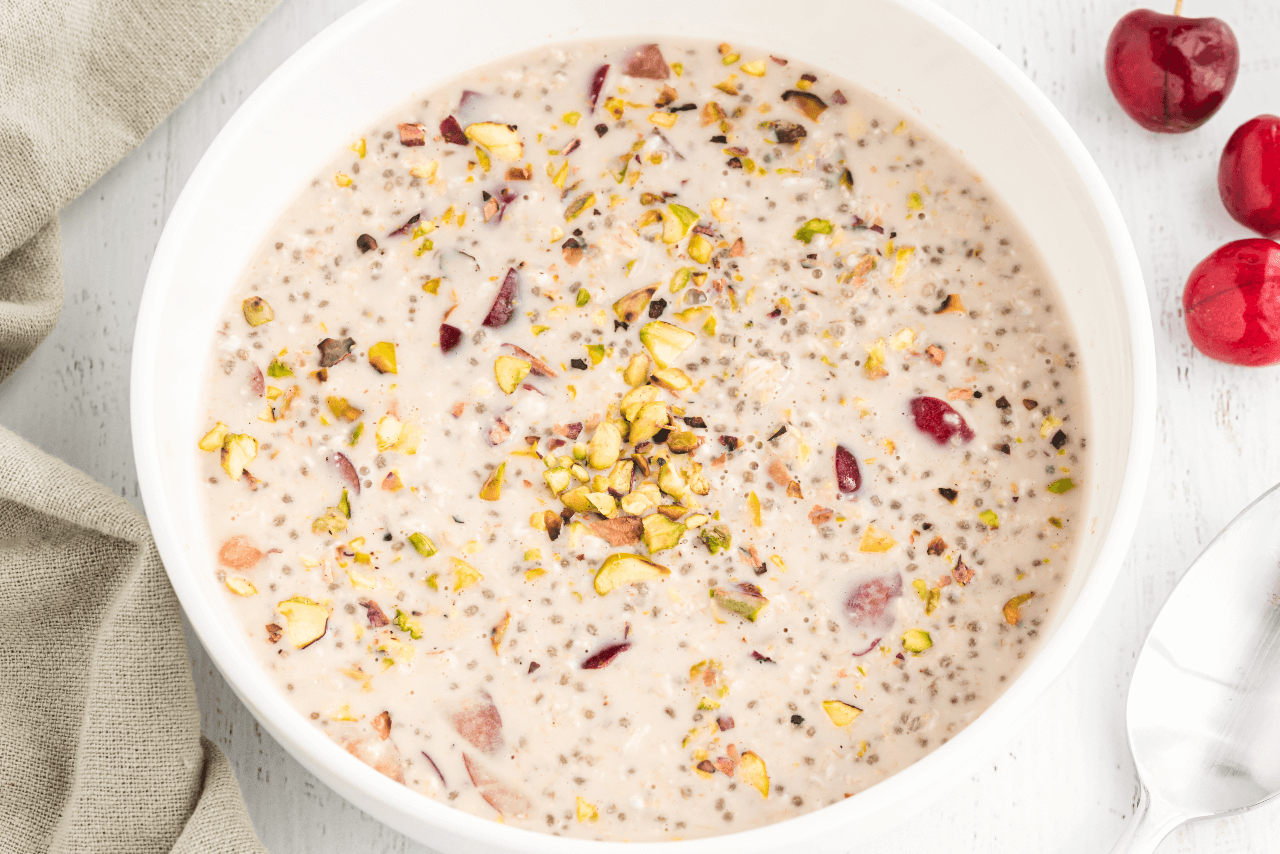
Toasted Pistachio and Cherry Overnight Oats are a tasty way to get a healthy dose of powerful plant nutrients. Oats, cherries, chia seeds, and pistachios offer a great deal of fiber, protein, and healthy fats. Not to mention, cherries and pistachios are packed with nutrients to fight inflammation from their abundant phytonutrients, making this a nourishing breakfast that provides long-lasting energy and health.
2. One Sheet Spicy Almond Tofu and Green Beans

Creamy almond butter breathes new life into protein-packed tofu and crisp green beans. In this recipe, the green beans are brushed with Spicy Almond Sauce before baking alongside the tofu and onions for a sheet pan meal that is efficient and scrumptious. Once everything’s done baking, pile your ingredients on top of rice (or your favorite whole grain), drizzle more nutty almond butter sauce on top, and garnish with additional flavors and textures for a restaurant-worthy nut recipe!
3. Fudgy Chocolate Chip and Walnut Brownies
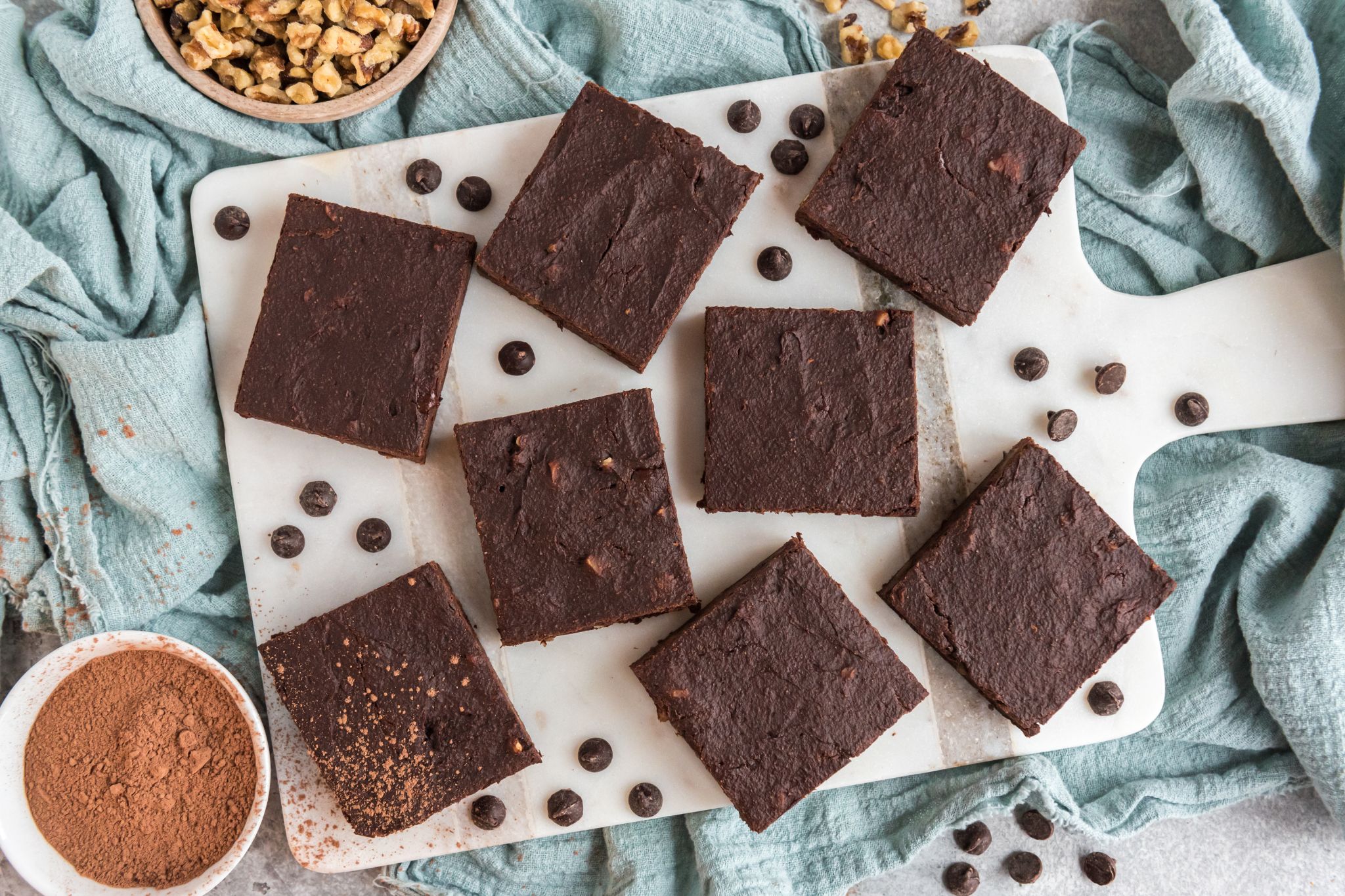
What’s better than a warm fudgy brownie? If you guessed a warm fudgy brownie with walnuts, you’d be correct! These Fudgy Chocolate Chip and Walnut Brownies may seem too good to be true, but you certainly can have your (plant-based) cake and eat it, too. Made with fiber-rich oat flour, dairy-free, fair-trade dark chocolate, applesauce, and mashed banana, these brownies will have you coming back again and again. With dense gooey chocolate, crunchy walnuts, and a fudgy texture, these brownies are a naturally sweet treat you’ll be excited to sink your teeth into!
You’d Be Nutty to Ignore Nuts!
No matter what type of nuts you enjoy, you will find beneficial qualities in them. Nuts are nutritional powerhouses providing a potent source of plant-based protein as well as healthy fats, vitamins, minerals, and antioxidants. Their robust nutritional profiles also explain why they’re so good for you. From protecting your heart health to prolonging your life to even helping you out in the bedroom, nuts have a lot to offer.
And while there are a few downsides of nuts to consider, overall, the benefits far outweigh any drawbacks (unless you’re allergic, of course). From homemade nut butters to salad toppings, nuts offer a versatile and convenient way to elevate both taste and well-being, making them an indispensable addition to a health-conscious diet.
Tell us in the comments:
- What are your favorite types of nuts?
- What health benefits of nuts are you most excited about?
- How do you like to eat nuts?
Featured Image: iStock.com/Mykola Sosiukin




